Health Care Report: Effectiveness of Safety Devices in Healthcare
VerifiedAdded on 2022/09/22
|12
|3217
|19
Report
AI Summary
This report investigates the effectiveness of Safety Engineered Devices (SEDs) in preventing needle stick injuries (NSIs) among healthcare workers. The research addresses the significant occupational hazard of NSIs, which expose healthcare professionals to bloodborne viruses. The study utilizes a systematic review approach, analyzing five research papers with varying methodologies, including quasi-experimental studies, integrative reviews, randomized controlled trials, and cohort studies. The findings consistently demonstrate the effectiveness of SEDs in reducing NSIs, with additional emphasis on the benefits of combining SEDs with training programs. The report highlights the importance of considering both the financial implications and human factors when implementing these devices. The conclusion supports the use of SEDs as a successful intervention to control the rate of NSIs and underscores the value of training in improving risk-related behaviors. The research emphasizes the need for further studies, particularly on successful implementation strategies within clinical settings.
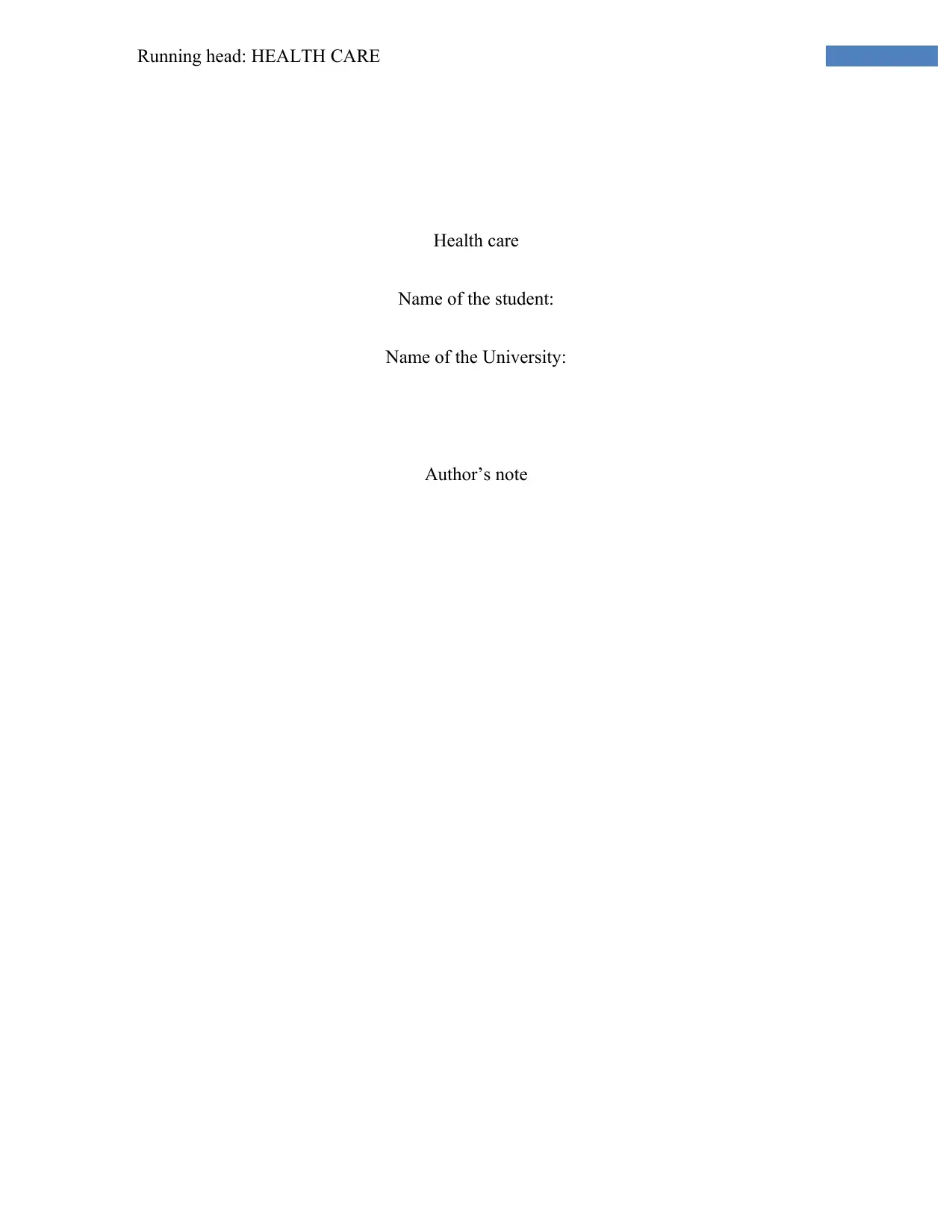
Running head: HEALTH CARE
Health care
Name of the student:
Name of the University:
Author’s note
Health care
Name of the student:
Name of the University:
Author’s note
Paraphrase This Document
Need a fresh take? Get an instant paraphrase of this document with our AI Paraphraser
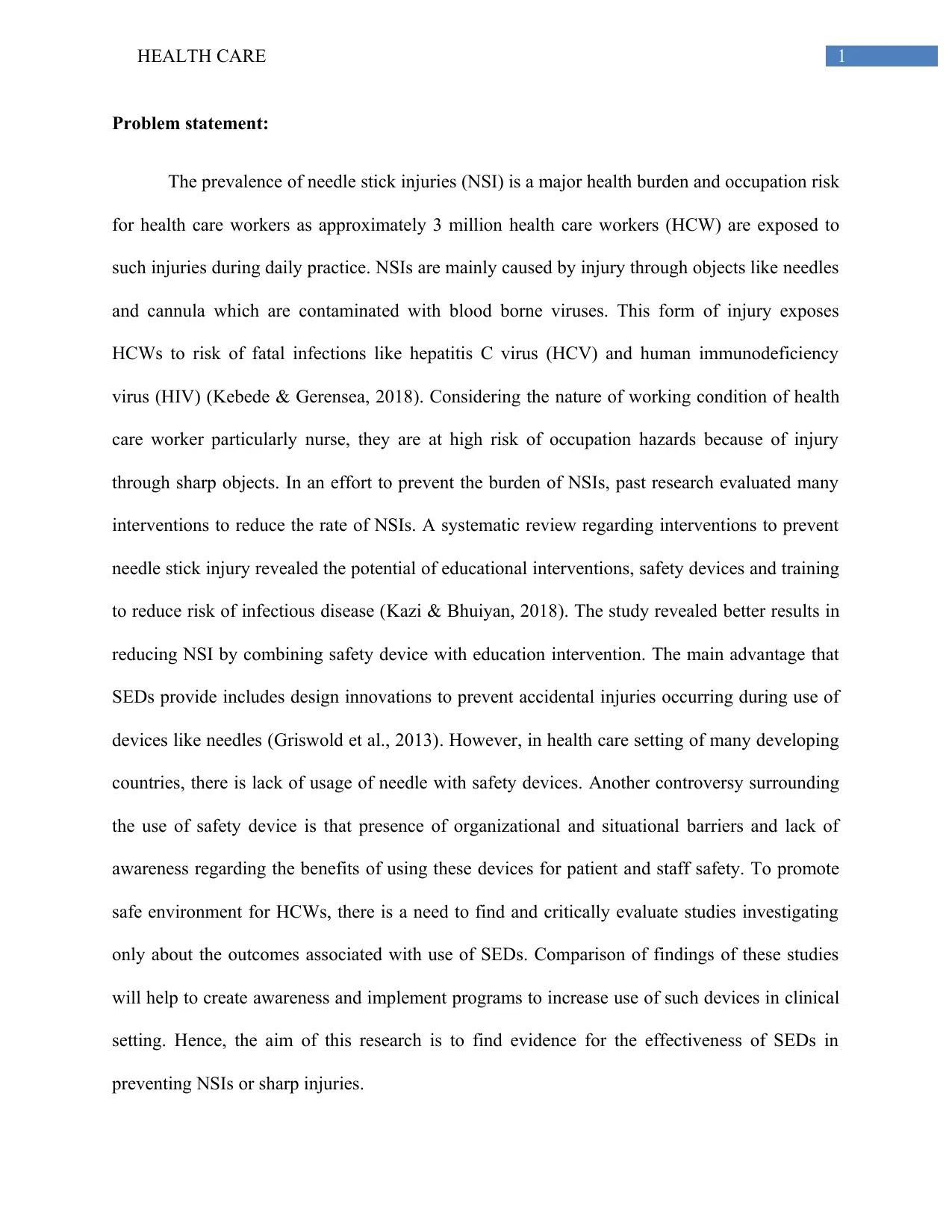
1HEALTH CARE
Problem statement:
The prevalence of needle stick injuries (NSI) is a major health burden and occupation risk
for health care workers as approximately 3 million health care workers (HCW) are exposed to
such injuries during daily practice. NSIs are mainly caused by injury through objects like needles
and cannula which are contaminated with blood borne viruses. This form of injury exposes
HCWs to risk of fatal infections like hepatitis C virus (HCV) and human immunodeficiency
virus (HIV) (Kebede & Gerensea, 2018). Considering the nature of working condition of health
care worker particularly nurse, they are at high risk of occupation hazards because of injury
through sharp objects. In an effort to prevent the burden of NSIs, past research evaluated many
interventions to reduce the rate of NSIs. A systematic review regarding interventions to prevent
needle stick injury revealed the potential of educational interventions, safety devices and training
to reduce risk of infectious disease (Kazi & Bhuiyan, 2018). The study revealed better results in
reducing NSI by combining safety device with education intervention. The main advantage that
SEDs provide includes design innovations to prevent accidental injuries occurring during use of
devices like needles (Griswold et al., 2013). However, in health care setting of many developing
countries, there is lack of usage of needle with safety devices. Another controversy surrounding
the use of safety device is that presence of organizational and situational barriers and lack of
awareness regarding the benefits of using these devices for patient and staff safety. To promote
safe environment for HCWs, there is a need to find and critically evaluate studies investigating
only about the outcomes associated with use of SEDs. Comparison of findings of these studies
will help to create awareness and implement programs to increase use of such devices in clinical
setting. Hence, the aim of this research is to find evidence for the effectiveness of SEDs in
preventing NSIs or sharp injuries.
Problem statement:
The prevalence of needle stick injuries (NSI) is a major health burden and occupation risk
for health care workers as approximately 3 million health care workers (HCW) are exposed to
such injuries during daily practice. NSIs are mainly caused by injury through objects like needles
and cannula which are contaminated with blood borne viruses. This form of injury exposes
HCWs to risk of fatal infections like hepatitis C virus (HCV) and human immunodeficiency
virus (HIV) (Kebede & Gerensea, 2018). Considering the nature of working condition of health
care worker particularly nurse, they are at high risk of occupation hazards because of injury
through sharp objects. In an effort to prevent the burden of NSIs, past research evaluated many
interventions to reduce the rate of NSIs. A systematic review regarding interventions to prevent
needle stick injury revealed the potential of educational interventions, safety devices and training
to reduce risk of infectious disease (Kazi & Bhuiyan, 2018). The study revealed better results in
reducing NSI by combining safety device with education intervention. The main advantage that
SEDs provide includes design innovations to prevent accidental injuries occurring during use of
devices like needles (Griswold et al., 2013). However, in health care setting of many developing
countries, there is lack of usage of needle with safety devices. Another controversy surrounding
the use of safety device is that presence of organizational and situational barriers and lack of
awareness regarding the benefits of using these devices for patient and staff safety. To promote
safe environment for HCWs, there is a need to find and critically evaluate studies investigating
only about the outcomes associated with use of SEDs. Comparison of findings of these studies
will help to create awareness and implement programs to increase use of such devices in clinical
setting. Hence, the aim of this research is to find evidence for the effectiveness of SEDs in
preventing NSIs or sharp injuries.
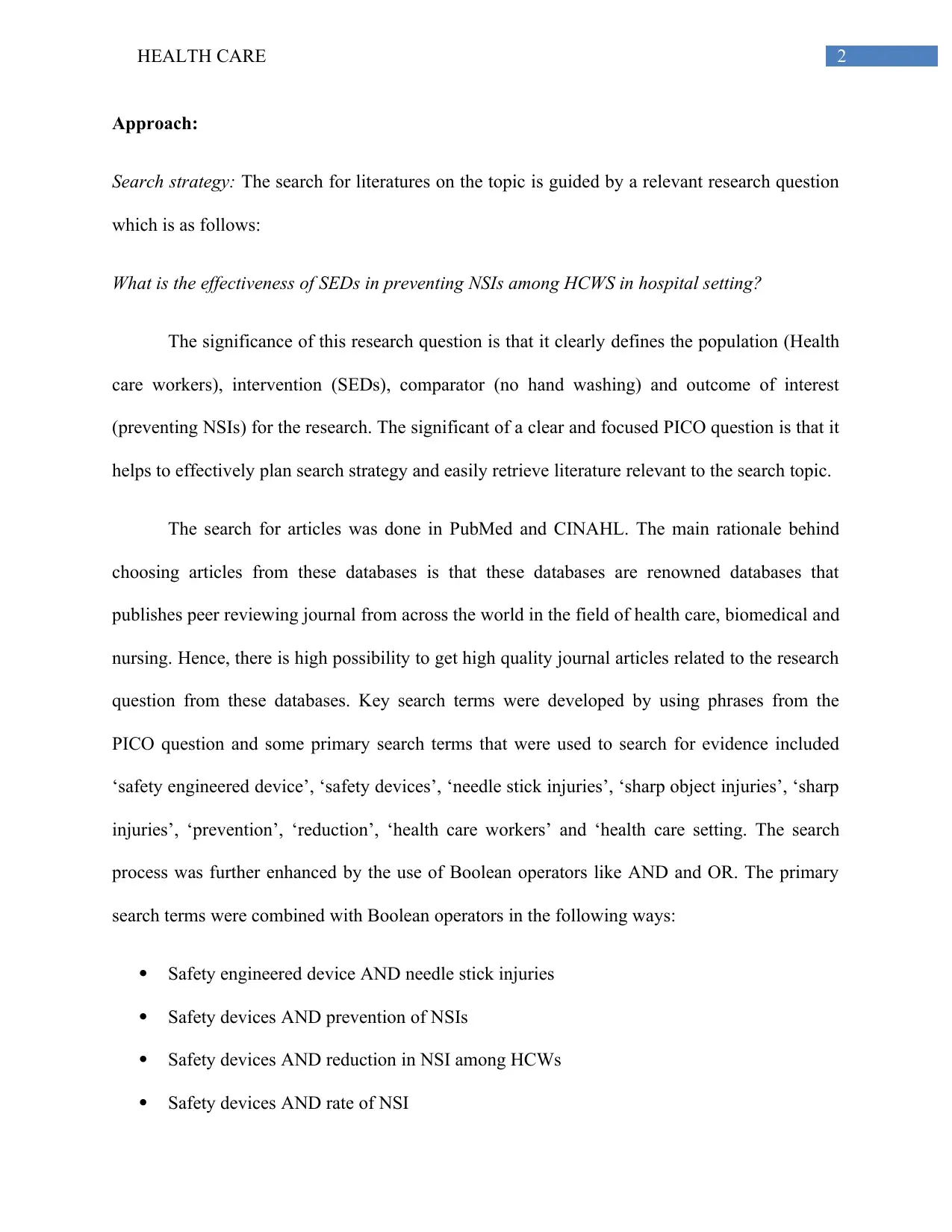
2HEALTH CARE
Approach:
Search strategy: The search for literatures on the topic is guided by a relevant research question
which is as follows:
What is the effectiveness of SEDs in preventing NSIs among HCWS in hospital setting?
The significance of this research question is that it clearly defines the population (Health
care workers), intervention (SEDs), comparator (no hand washing) and outcome of interest
(preventing NSIs) for the research. The significant of a clear and focused PICO question is that it
helps to effectively plan search strategy and easily retrieve literature relevant to the search topic.
The search for articles was done in PubMed and CINAHL. The main rationale behind
choosing articles from these databases is that these databases are renowned databases that
publishes peer reviewing journal from across the world in the field of health care, biomedical and
nursing. Hence, there is high possibility to get high quality journal articles related to the research
question from these databases. Key search terms were developed by using phrases from the
PICO question and some primary search terms that were used to search for evidence included
‘safety engineered device’, ‘safety devices’, ‘needle stick injuries’, ‘sharp object injuries’, ‘sharp
injuries’, ‘prevention’, ‘reduction’, ‘health care workers’ and ‘health care setting. The search
process was further enhanced by the use of Boolean operators like AND and OR. The primary
search terms were combined with Boolean operators in the following ways:
Safety engineered device AND needle stick injuries
Safety devices AND prevention of NSIs
Safety devices AND reduction in NSI among HCWs
Safety devices AND rate of NSI
Approach:
Search strategy: The search for literatures on the topic is guided by a relevant research question
which is as follows:
What is the effectiveness of SEDs in preventing NSIs among HCWS in hospital setting?
The significance of this research question is that it clearly defines the population (Health
care workers), intervention (SEDs), comparator (no hand washing) and outcome of interest
(preventing NSIs) for the research. The significant of a clear and focused PICO question is that it
helps to effectively plan search strategy and easily retrieve literature relevant to the search topic.
The search for articles was done in PubMed and CINAHL. The main rationale behind
choosing articles from these databases is that these databases are renowned databases that
publishes peer reviewing journal from across the world in the field of health care, biomedical and
nursing. Hence, there is high possibility to get high quality journal articles related to the research
question from these databases. Key search terms were developed by using phrases from the
PICO question and some primary search terms that were used to search for evidence included
‘safety engineered device’, ‘safety devices’, ‘needle stick injuries’, ‘sharp object injuries’, ‘sharp
injuries’, ‘prevention’, ‘reduction’, ‘health care workers’ and ‘health care setting. The search
process was further enhanced by the use of Boolean operators like AND and OR. The primary
search terms were combined with Boolean operators in the following ways:
Safety engineered device AND needle stick injuries
Safety devices AND prevention of NSIs
Safety devices AND reduction in NSI among HCWs
Safety devices AND rate of NSI
⊘ This is a preview!⊘
Do you want full access?
Subscribe today to unlock all pages.

Trusted by 1+ million students worldwide
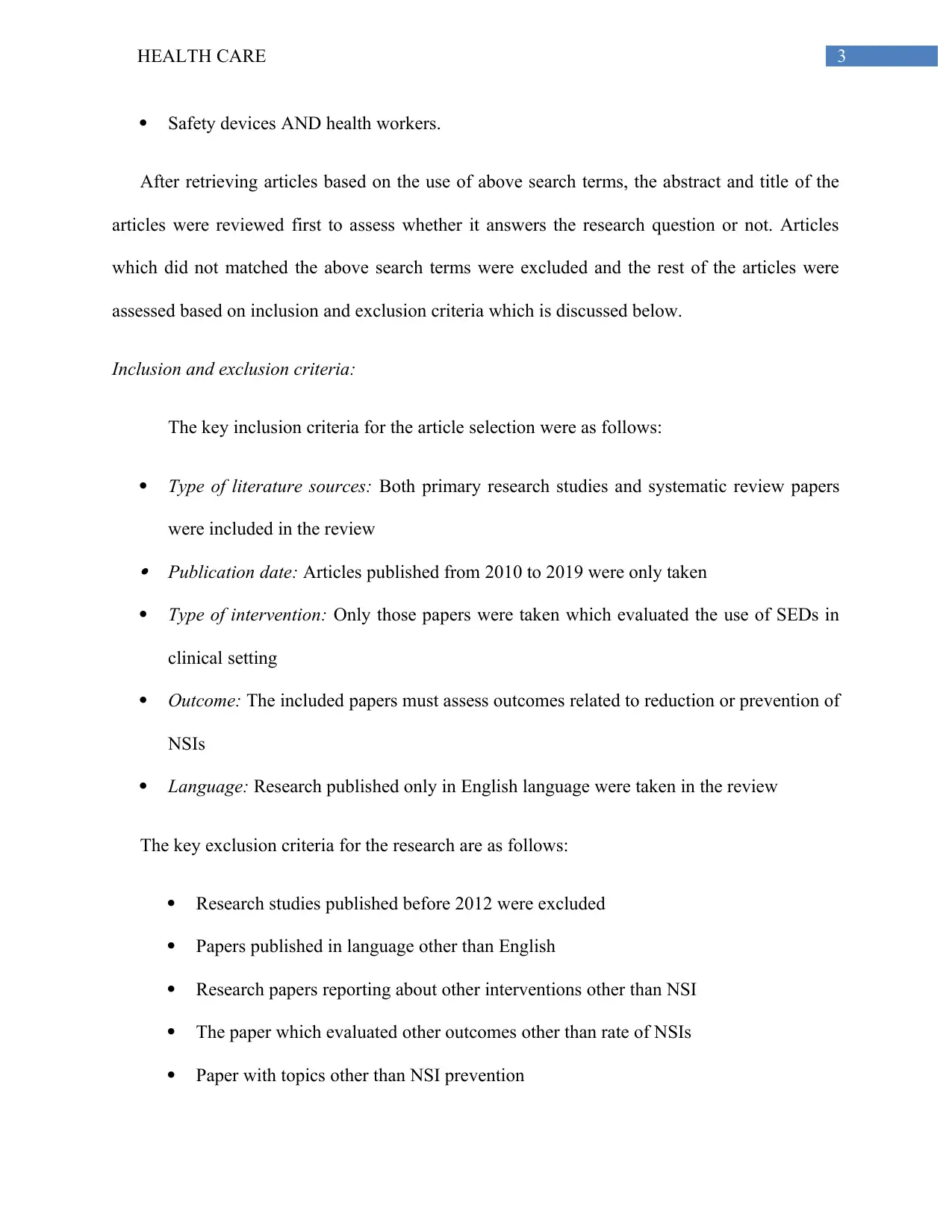
3HEALTH CARE
Safety devices AND health workers.
After retrieving articles based on the use of above search terms, the abstract and title of the
articles were reviewed first to assess whether it answers the research question or not. Articles
which did not matched the above search terms were excluded and the rest of the articles were
assessed based on inclusion and exclusion criteria which is discussed below.
Inclusion and exclusion criteria:
The key inclusion criteria for the article selection were as follows:
Type of literature sources: Both primary research studies and systematic review papers
were included in the review Publication date: Articles published from 2010 to 2019 were only taken
Type of intervention: Only those papers were taken which evaluated the use of SEDs in
clinical setting
Outcome: The included papers must assess outcomes related to reduction or prevention of
NSIs
Language: Research published only in English language were taken in the review
The key exclusion criteria for the research are as follows:
Research studies published before 2012 were excluded
Papers published in language other than English
Research papers reporting about other interventions other than NSI
The paper which evaluated other outcomes other than rate of NSIs
Paper with topics other than NSI prevention
Safety devices AND health workers.
After retrieving articles based on the use of above search terms, the abstract and title of the
articles were reviewed first to assess whether it answers the research question or not. Articles
which did not matched the above search terms were excluded and the rest of the articles were
assessed based on inclusion and exclusion criteria which is discussed below.
Inclusion and exclusion criteria:
The key inclusion criteria for the article selection were as follows:
Type of literature sources: Both primary research studies and systematic review papers
were included in the review Publication date: Articles published from 2010 to 2019 were only taken
Type of intervention: Only those papers were taken which evaluated the use of SEDs in
clinical setting
Outcome: The included papers must assess outcomes related to reduction or prevention of
NSIs
Language: Research published only in English language were taken in the review
The key exclusion criteria for the research are as follows:
Research studies published before 2012 were excluded
Papers published in language other than English
Research papers reporting about other interventions other than NSI
The paper which evaluated other outcomes other than rate of NSIs
Paper with topics other than NSI prevention
Paraphrase This Document
Need a fresh take? Get an instant paraphrase of this document with our AI Paraphraser
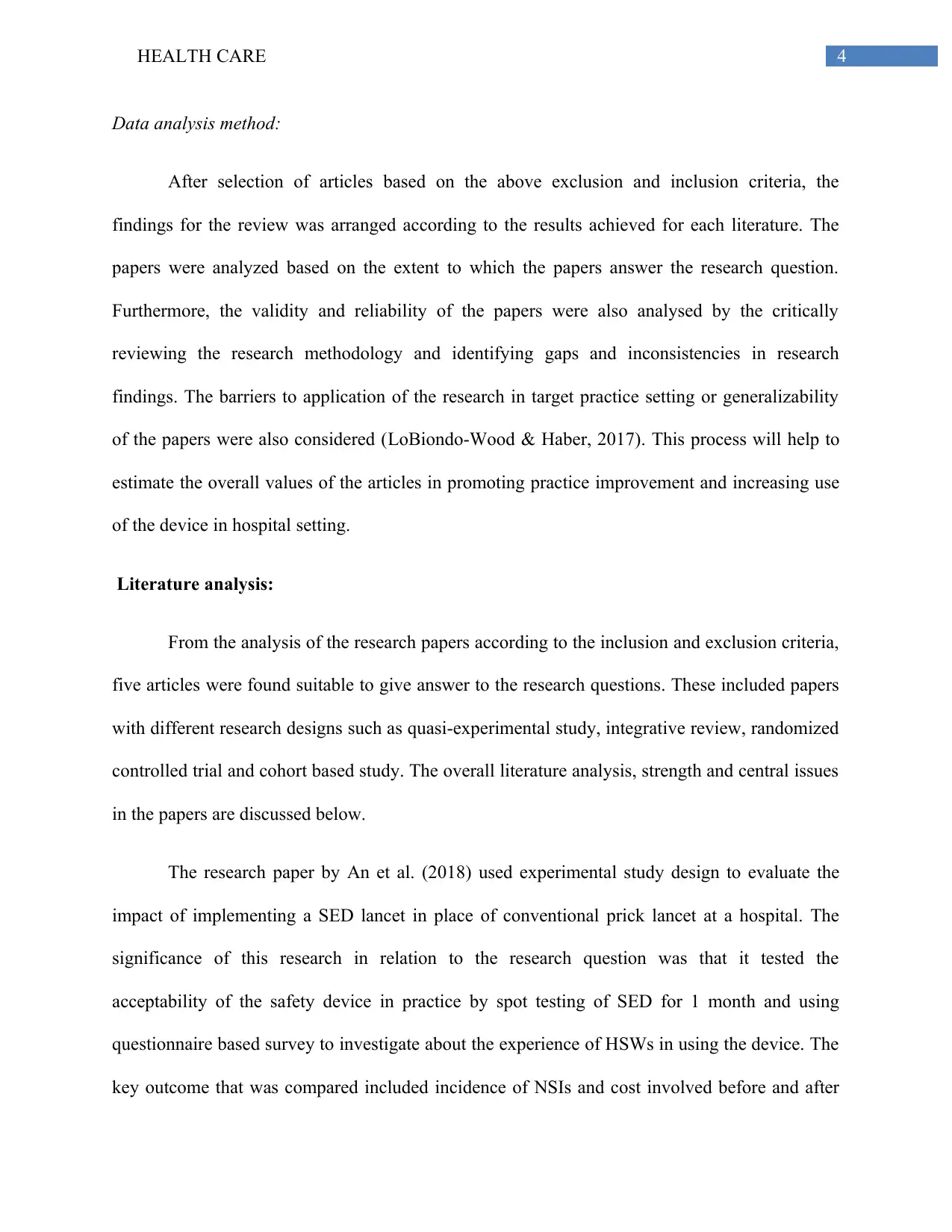
4HEALTH CARE
Data analysis method:
After selection of articles based on the above exclusion and inclusion criteria, the
findings for the review was arranged according to the results achieved for each literature. The
papers were analyzed based on the extent to which the papers answer the research question.
Furthermore, the validity and reliability of the papers were also analysed by the critically
reviewing the research methodology and identifying gaps and inconsistencies in research
findings. The barriers to application of the research in target practice setting or generalizability
of the papers were also considered (LoBiondo-Wood & Haber, 2017). This process will help to
estimate the overall values of the articles in promoting practice improvement and increasing use
of the device in hospital setting.
Literature analysis:
From the analysis of the research papers according to the inclusion and exclusion criteria,
five articles were found suitable to give answer to the research questions. These included papers
with different research designs such as quasi-experimental study, integrative review, randomized
controlled trial and cohort based study. The overall literature analysis, strength and central issues
in the papers are discussed below.
The research paper by An et al. (2018) used experimental study design to evaluate the
impact of implementing a SED lancet in place of conventional prick lancet at a hospital. The
significance of this research in relation to the research question was that it tested the
acceptability of the safety device in practice by spot testing of SED for 1 month and using
questionnaire based survey to investigate about the experience of HSWs in using the device. The
key outcome that was compared included incidence of NSIs and cost involved before and after
Data analysis method:
After selection of articles based on the above exclusion and inclusion criteria, the
findings for the review was arranged according to the results achieved for each literature. The
papers were analyzed based on the extent to which the papers answer the research question.
Furthermore, the validity and reliability of the papers were also analysed by the critically
reviewing the research methodology and identifying gaps and inconsistencies in research
findings. The barriers to application of the research in target practice setting or generalizability
of the papers were also considered (LoBiondo-Wood & Haber, 2017). This process will help to
estimate the overall values of the articles in promoting practice improvement and increasing use
of the device in hospital setting.
Literature analysis:
From the analysis of the research papers according to the inclusion and exclusion criteria,
five articles were found suitable to give answer to the research questions. These included papers
with different research designs such as quasi-experimental study, integrative review, randomized
controlled trial and cohort based study. The overall literature analysis, strength and central issues
in the papers are discussed below.
The research paper by An et al. (2018) used experimental study design to evaluate the
impact of implementing a SED lancet in place of conventional prick lancet at a hospital. The
significance of this research in relation to the research question was that it tested the
acceptability of the safety device in practice by spot testing of SED for 1 month and using
questionnaire based survey to investigate about the experience of HSWs in using the device. The
key outcome that was compared included incidence of NSIs and cost involved before and after
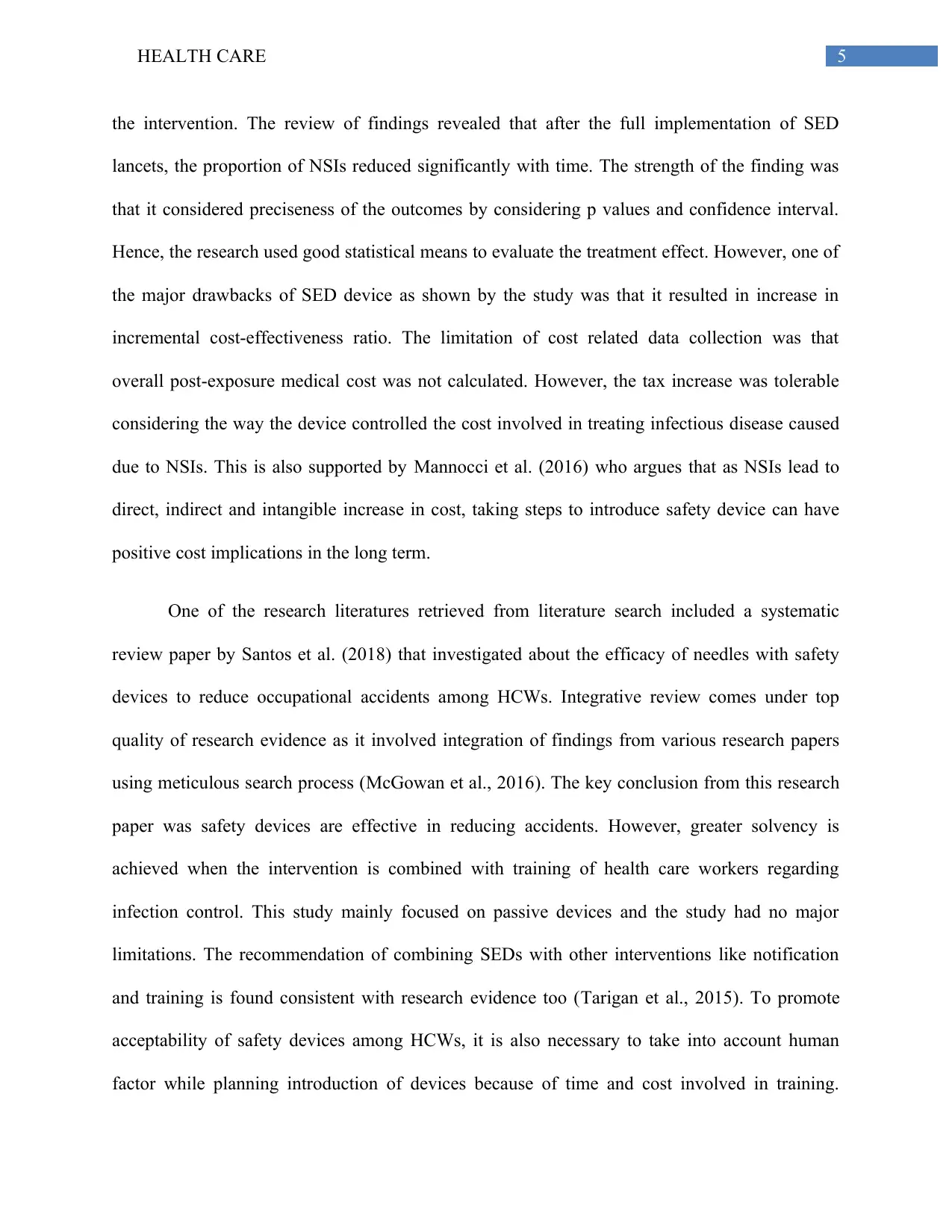
5HEALTH CARE
the intervention. The review of findings revealed that after the full implementation of SED
lancets, the proportion of NSIs reduced significantly with time. The strength of the finding was
that it considered preciseness of the outcomes by considering p values and confidence interval.
Hence, the research used good statistical means to evaluate the treatment effect. However, one of
the major drawbacks of SED device as shown by the study was that it resulted in increase in
incremental cost-effectiveness ratio. The limitation of cost related data collection was that
overall post-exposure medical cost was not calculated. However, the tax increase was tolerable
considering the way the device controlled the cost involved in treating infectious disease caused
due to NSIs. This is also supported by Mannocci et al. (2016) who argues that as NSIs lead to
direct, indirect and intangible increase in cost, taking steps to introduce safety device can have
positive cost implications in the long term.
One of the research literatures retrieved from literature search included a systematic
review paper by Santos et al. (2018) that investigated about the efficacy of needles with safety
devices to reduce occupational accidents among HCWs. Integrative review comes under top
quality of research evidence as it involved integration of findings from various research papers
using meticulous search process (McGowan et al., 2016). The key conclusion from this research
paper was safety devices are effective in reducing accidents. However, greater solvency is
achieved when the intervention is combined with training of health care workers regarding
infection control. This study mainly focused on passive devices and the study had no major
limitations. The recommendation of combining SEDs with other interventions like notification
and training is found consistent with research evidence too (Tarigan et al., 2015). To promote
acceptability of safety devices among HCWs, it is also necessary to take into account human
factor while planning introduction of devices because of time and cost involved in training.
the intervention. The review of findings revealed that after the full implementation of SED
lancets, the proportion of NSIs reduced significantly with time. The strength of the finding was
that it considered preciseness of the outcomes by considering p values and confidence interval.
Hence, the research used good statistical means to evaluate the treatment effect. However, one of
the major drawbacks of SED device as shown by the study was that it resulted in increase in
incremental cost-effectiveness ratio. The limitation of cost related data collection was that
overall post-exposure medical cost was not calculated. However, the tax increase was tolerable
considering the way the device controlled the cost involved in treating infectious disease caused
due to NSIs. This is also supported by Mannocci et al. (2016) who argues that as NSIs lead to
direct, indirect and intangible increase in cost, taking steps to introduce safety device can have
positive cost implications in the long term.
One of the research literatures retrieved from literature search included a systematic
review paper by Santos et al. (2018) that investigated about the efficacy of needles with safety
devices to reduce occupational accidents among HCWs. Integrative review comes under top
quality of research evidence as it involved integration of findings from various research papers
using meticulous search process (McGowan et al., 2016). The key conclusion from this research
paper was safety devices are effective in reducing accidents. However, greater solvency is
achieved when the intervention is combined with training of health care workers regarding
infection control. This study mainly focused on passive devices and the study had no major
limitations. The recommendation of combining SEDs with other interventions like notification
and training is found consistent with research evidence too (Tarigan et al., 2015). To promote
acceptability of safety devices among HCWs, it is also necessary to take into account human
factor while planning introduction of devices because of time and cost involved in training.
⊘ This is a preview!⊘
Do you want full access?
Subscribe today to unlock all pages.

Trusted by 1+ million students worldwide
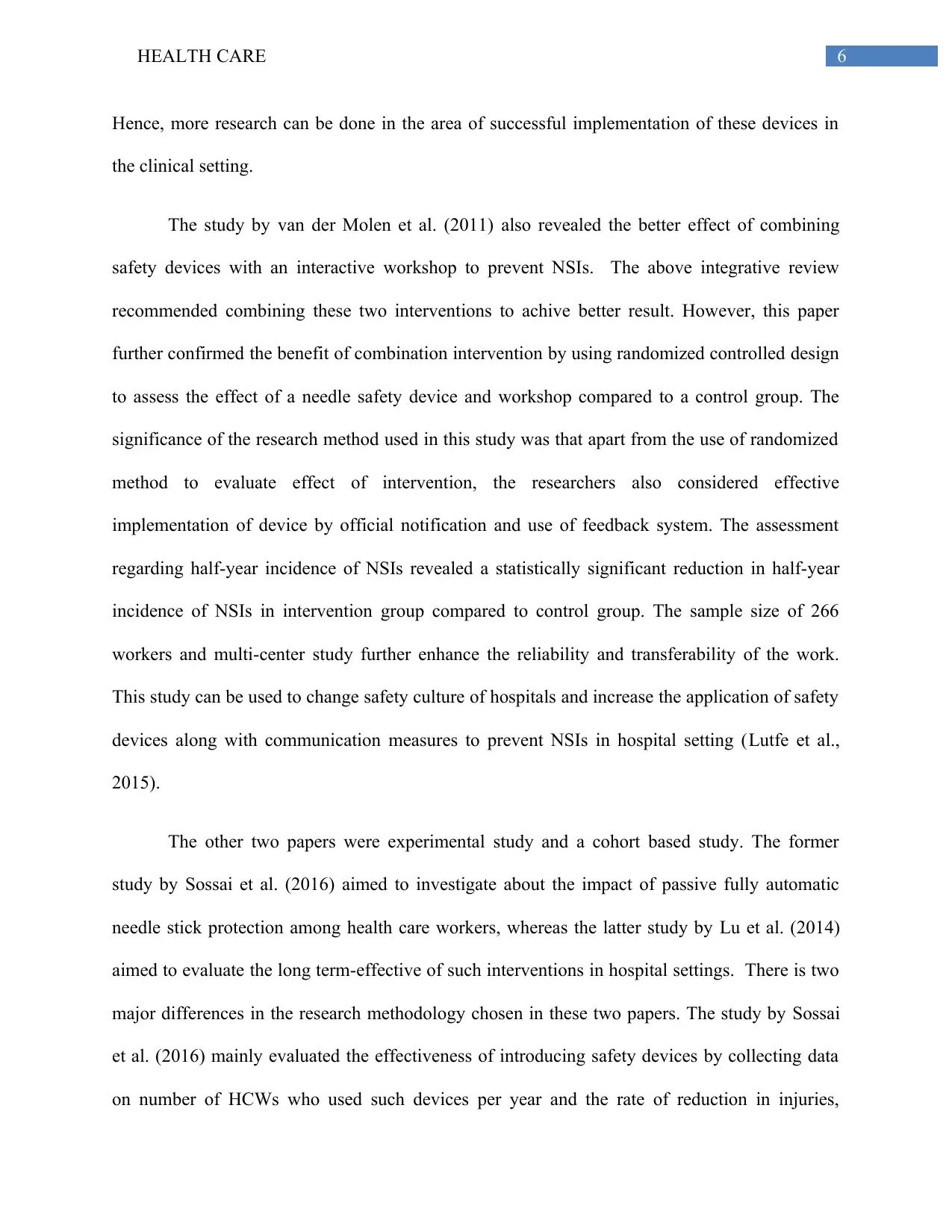
6HEALTH CARE
Hence, more research can be done in the area of successful implementation of these devices in
the clinical setting.
The study by van der Molen et al. (2011) also revealed the better effect of combining
safety devices with an interactive workshop to prevent NSIs. The above integrative review
recommended combining these two interventions to achive better result. However, this paper
further confirmed the benefit of combination intervention by using randomized controlled design
to assess the effect of a needle safety device and workshop compared to a control group. The
significance of the research method used in this study was that apart from the use of randomized
method to evaluate effect of intervention, the researchers also considered effective
implementation of device by official notification and use of feedback system. The assessment
regarding half-year incidence of NSIs revealed a statistically significant reduction in half-year
incidence of NSIs in intervention group compared to control group. The sample size of 266
workers and multi-center study further enhance the reliability and transferability of the work.
This study can be used to change safety culture of hospitals and increase the application of safety
devices along with communication measures to prevent NSIs in hospital setting (Lutfe et al.,
2015).
The other two papers were experimental study and a cohort based study. The former
study by Sossai et al. (2016) aimed to investigate about the impact of passive fully automatic
needle stick protection among health care workers, whereas the latter study by Lu et al. (2014)
aimed to evaluate the long term-effective of such interventions in hospital settings. There is two
major differences in the research methodology chosen in these two papers. The study by Sossai
et al. (2016) mainly evaluated the effectiveness of introducing safety devices by collecting data
on number of HCWs who used such devices per year and the rate of reduction in injuries,
Hence, more research can be done in the area of successful implementation of these devices in
the clinical setting.
The study by van der Molen et al. (2011) also revealed the better effect of combining
safety devices with an interactive workshop to prevent NSIs. The above integrative review
recommended combining these two interventions to achive better result. However, this paper
further confirmed the benefit of combination intervention by using randomized controlled design
to assess the effect of a needle safety device and workshop compared to a control group. The
significance of the research method used in this study was that apart from the use of randomized
method to evaluate effect of intervention, the researchers also considered effective
implementation of device by official notification and use of feedback system. The assessment
regarding half-year incidence of NSIs revealed a statistically significant reduction in half-year
incidence of NSIs in intervention group compared to control group. The sample size of 266
workers and multi-center study further enhance the reliability and transferability of the work.
This study can be used to change safety culture of hospitals and increase the application of safety
devices along with communication measures to prevent NSIs in hospital setting (Lutfe et al.,
2015).
The other two papers were experimental study and a cohort based study. The former
study by Sossai et al. (2016) aimed to investigate about the impact of passive fully automatic
needle stick protection among health care workers, whereas the latter study by Lu et al. (2014)
aimed to evaluate the long term-effective of such interventions in hospital settings. There is two
major differences in the research methodology chosen in these two papers. The study by Sossai
et al. (2016) mainly evaluated the effectiveness of introducing safety devices by collecting data
on number of HCWs who used such devices per year and the rate of reduction in injuries,
Paraphrase This Document
Need a fresh take? Get an instant paraphrase of this document with our AI Paraphraser
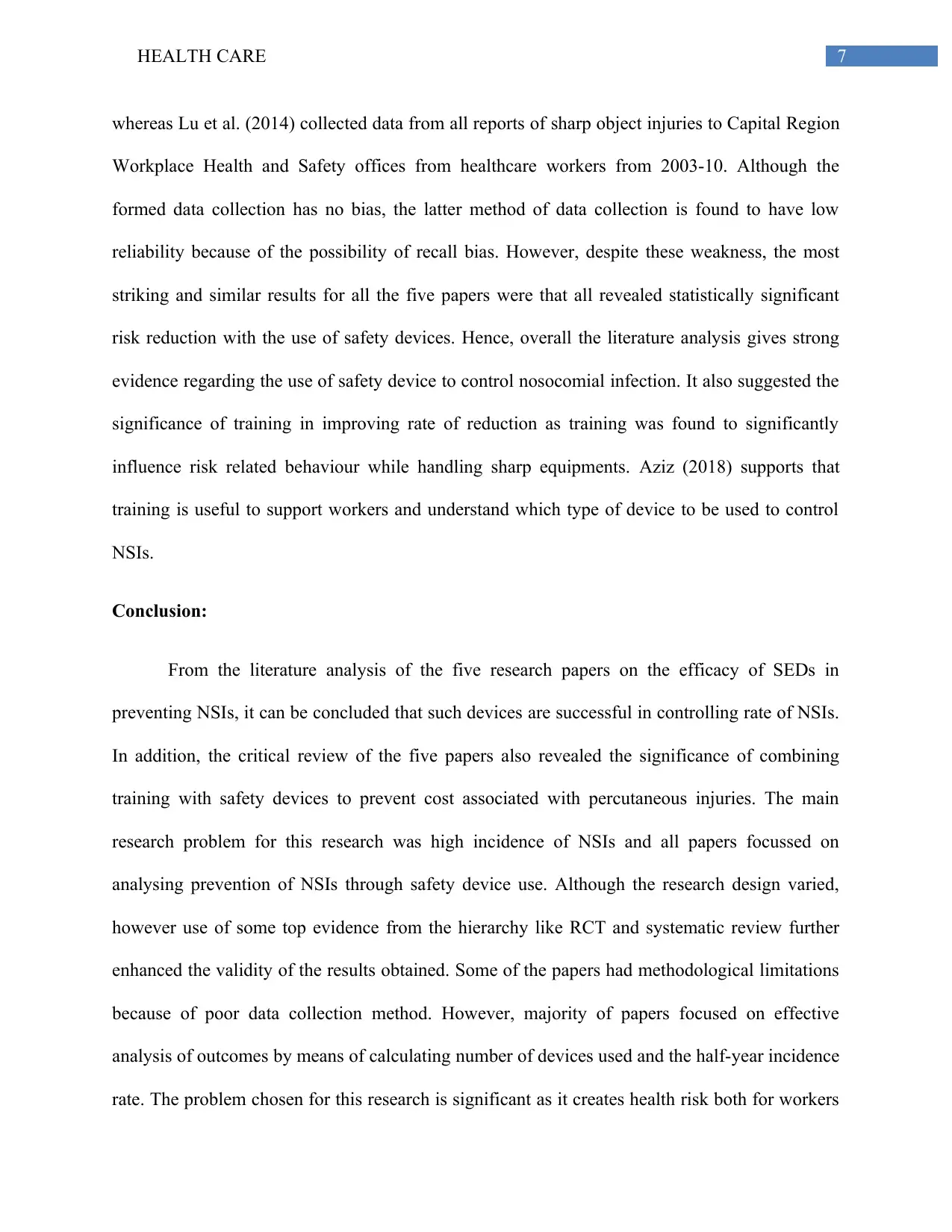
7HEALTH CARE
whereas Lu et al. (2014) collected data from all reports of sharp object injuries to Capital Region
Workplace Health and Safety offices from healthcare workers from 2003-10. Although the
formed data collection has no bias, the latter method of data collection is found to have low
reliability because of the possibility of recall bias. However, despite these weakness, the most
striking and similar results for all the five papers were that all revealed statistically significant
risk reduction with the use of safety devices. Hence, overall the literature analysis gives strong
evidence regarding the use of safety device to control nosocomial infection. It also suggested the
significance of training in improving rate of reduction as training was found to significantly
influence risk related behaviour while handling sharp equipments. Aziz (2018) supports that
training is useful to support workers and understand which type of device to be used to control
NSIs.
Conclusion:
From the literature analysis of the five research papers on the efficacy of SEDs in
preventing NSIs, it can be concluded that such devices are successful in controlling rate of NSIs.
In addition, the critical review of the five papers also revealed the significance of combining
training with safety devices to prevent cost associated with percutaneous injuries. The main
research problem for this research was high incidence of NSIs and all papers focussed on
analysing prevention of NSIs through safety device use. Although the research design varied,
however use of some top evidence from the hierarchy like RCT and systematic review further
enhanced the validity of the results obtained. Some of the papers had methodological limitations
because of poor data collection method. However, majority of papers focused on effective
analysis of outcomes by means of calculating number of devices used and the half-year incidence
rate. The problem chosen for this research is significant as it creates health risk both for workers
whereas Lu et al. (2014) collected data from all reports of sharp object injuries to Capital Region
Workplace Health and Safety offices from healthcare workers from 2003-10. Although the
formed data collection has no bias, the latter method of data collection is found to have low
reliability because of the possibility of recall bias. However, despite these weakness, the most
striking and similar results for all the five papers were that all revealed statistically significant
risk reduction with the use of safety devices. Hence, overall the literature analysis gives strong
evidence regarding the use of safety device to control nosocomial infection. It also suggested the
significance of training in improving rate of reduction as training was found to significantly
influence risk related behaviour while handling sharp equipments. Aziz (2018) supports that
training is useful to support workers and understand which type of device to be used to control
NSIs.
Conclusion:
From the literature analysis of the five research papers on the efficacy of SEDs in
preventing NSIs, it can be concluded that such devices are successful in controlling rate of NSIs.
In addition, the critical review of the five papers also revealed the significance of combining
training with safety devices to prevent cost associated with percutaneous injuries. The main
research problem for this research was high incidence of NSIs and all papers focussed on
analysing prevention of NSIs through safety device use. Although the research design varied,
however use of some top evidence from the hierarchy like RCT and systematic review further
enhanced the validity of the results obtained. Some of the papers had methodological limitations
because of poor data collection method. However, majority of papers focused on effective
analysis of outcomes by means of calculating number of devices used and the half-year incidence
rate. The problem chosen for this research is significant as it creates health risk both for workers
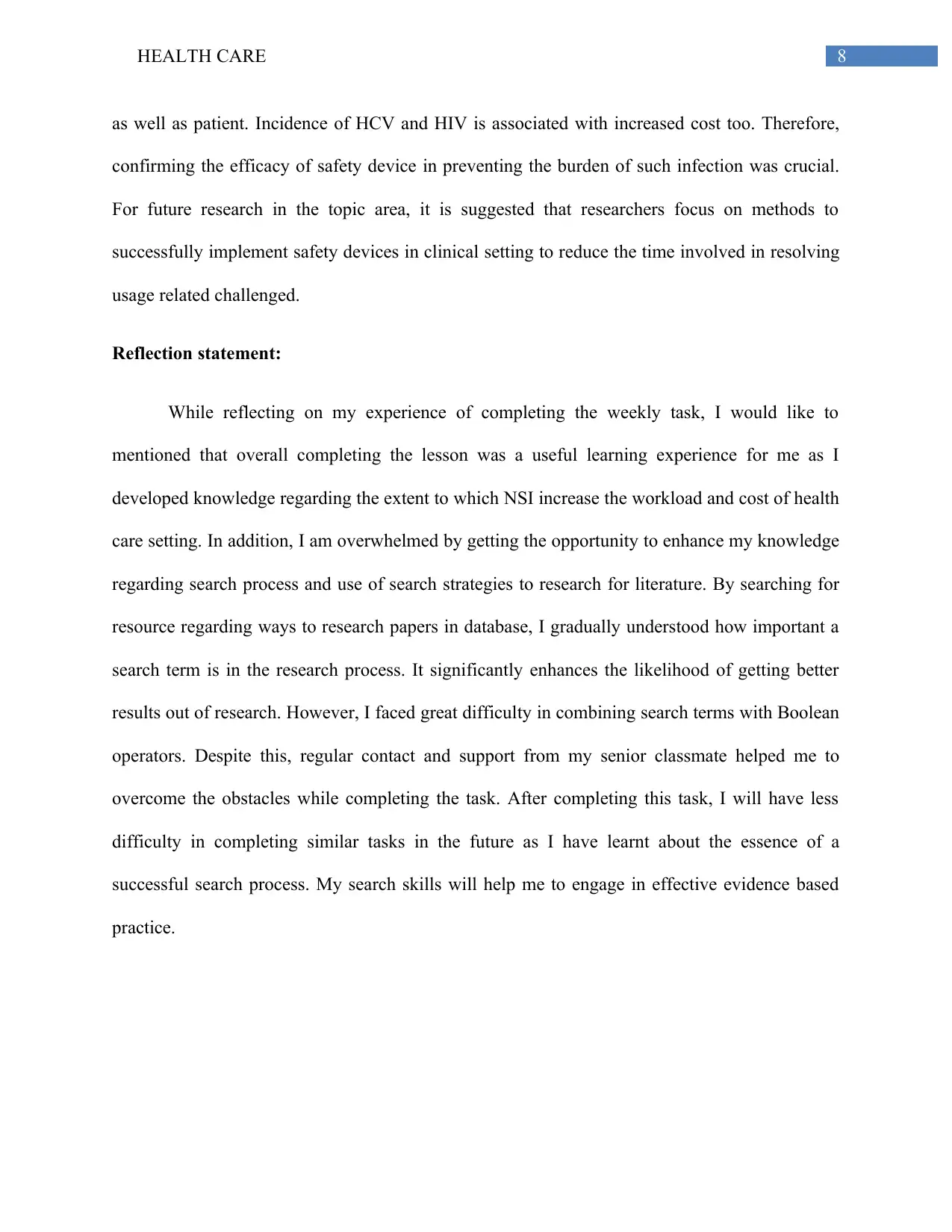
8HEALTH CARE
as well as patient. Incidence of HCV and HIV is associated with increased cost too. Therefore,
confirming the efficacy of safety device in preventing the burden of such infection was crucial.
For future research in the topic area, it is suggested that researchers focus on methods to
successfully implement safety devices in clinical setting to reduce the time involved in resolving
usage related challenged.
Reflection statement:
While reflecting on my experience of completing the weekly task, I would like to
mentioned that overall completing the lesson was a useful learning experience for me as I
developed knowledge regarding the extent to which NSI increase the workload and cost of health
care setting. In addition, I am overwhelmed by getting the opportunity to enhance my knowledge
regarding search process and use of search strategies to research for literature. By searching for
resource regarding ways to research papers in database, I gradually understood how important a
search term is in the research process. It significantly enhances the likelihood of getting better
results out of research. However, I faced great difficulty in combining search terms with Boolean
operators. Despite this, regular contact and support from my senior classmate helped me to
overcome the obstacles while completing the task. After completing this task, I will have less
difficulty in completing similar tasks in the future as I have learnt about the essence of a
successful search process. My search skills will help me to engage in effective evidence based
practice.
as well as patient. Incidence of HCV and HIV is associated with increased cost too. Therefore,
confirming the efficacy of safety device in preventing the burden of such infection was crucial.
For future research in the topic area, it is suggested that researchers focus on methods to
successfully implement safety devices in clinical setting to reduce the time involved in resolving
usage related challenged.
Reflection statement:
While reflecting on my experience of completing the weekly task, I would like to
mentioned that overall completing the lesson was a useful learning experience for me as I
developed knowledge regarding the extent to which NSI increase the workload and cost of health
care setting. In addition, I am overwhelmed by getting the opportunity to enhance my knowledge
regarding search process and use of search strategies to research for literature. By searching for
resource regarding ways to research papers in database, I gradually understood how important a
search term is in the research process. It significantly enhances the likelihood of getting better
results out of research. However, I faced great difficulty in combining search terms with Boolean
operators. Despite this, regular contact and support from my senior classmate helped me to
overcome the obstacles while completing the task. After completing this task, I will have less
difficulty in completing similar tasks in the future as I have learnt about the essence of a
successful search process. My search skills will help me to engage in effective evidence based
practice.
⊘ This is a preview!⊘
Do you want full access?
Subscribe today to unlock all pages.

Trusted by 1+ million students worldwide

9HEALTH CARE
References:
An, H. S., Ko, S., Bang, J. H., & Park, S. W. (2018). Elimination of Lancet-Related Needlestick
Injuries Using a Safety-Engineered Lancet: Experience in a Hospital. Infection &
chemotherapy, 50(4), 319-327.
Aziz, A. M. (2018). Do training and needle-safety devices prevent needlestick injuries? A
systematised review of the literature. British Journal of Nursing, 27(16), 944-952.
Griswold, S., Bonaroti, A., Rieder, C. J., Erbayri, J., Parsons, J., Nocera, R., & Hamilton, R.
(2013). Investigation of a safety-engineered device to prevent needlestick injury: why has
not StatLock stuck?. BMJ open, 3(4), e002327.
Kazi, W., & Bhuiyan, S. (2018). A Systematic Review on Interventions to Decrease the Rate of
Needlestick Injury Associated Blood-Borne Diseases among the Healthcare Workers in
the Low Resource Developing Countries. EC Emergency Medicine and Critical Care, 2,
97-109.
Kebede, A., & Gerensea, H. (2018). Prevalence of needle stick injury and its associated factors
among nurses working in public hospitals of Dessie town, Northeast Ethiopia,
2016. BMC research notes, 11(1), 413.
LoBiondo-Wood, G., & Haber, J. (2017). Nursing research-E-book: methods and critical
appraisal for evidence-based practice. Elsevier Health Sciences.
Lu, Y., Senthilselvan, A., Joffe, A. M., & Beach, J. (2014). Effectiveness of safety-engineered
devices in reducing sharp object injuries. Occupational Medicine, 65(1), 39-44.
References:
An, H. S., Ko, S., Bang, J. H., & Park, S. W. (2018). Elimination of Lancet-Related Needlestick
Injuries Using a Safety-Engineered Lancet: Experience in a Hospital. Infection &
chemotherapy, 50(4), 319-327.
Aziz, A. M. (2018). Do training and needle-safety devices prevent needlestick injuries? A
systematised review of the literature. British Journal of Nursing, 27(16), 944-952.
Griswold, S., Bonaroti, A., Rieder, C. J., Erbayri, J., Parsons, J., Nocera, R., & Hamilton, R.
(2013). Investigation of a safety-engineered device to prevent needlestick injury: why has
not StatLock stuck?. BMJ open, 3(4), e002327.
Kazi, W., & Bhuiyan, S. (2018). A Systematic Review on Interventions to Decrease the Rate of
Needlestick Injury Associated Blood-Borne Diseases among the Healthcare Workers in
the Low Resource Developing Countries. EC Emergency Medicine and Critical Care, 2,
97-109.
Kebede, A., & Gerensea, H. (2018). Prevalence of needle stick injury and its associated factors
among nurses working in public hospitals of Dessie town, Northeast Ethiopia,
2016. BMC research notes, 11(1), 413.
LoBiondo-Wood, G., & Haber, J. (2017). Nursing research-E-book: methods and critical
appraisal for evidence-based practice. Elsevier Health Sciences.
Lu, Y., Senthilselvan, A., Joffe, A. M., & Beach, J. (2014). Effectiveness of safety-engineered
devices in reducing sharp object injuries. Occupational Medicine, 65(1), 39-44.
Paraphrase This Document
Need a fresh take? Get an instant paraphrase of this document with our AI Paraphraser
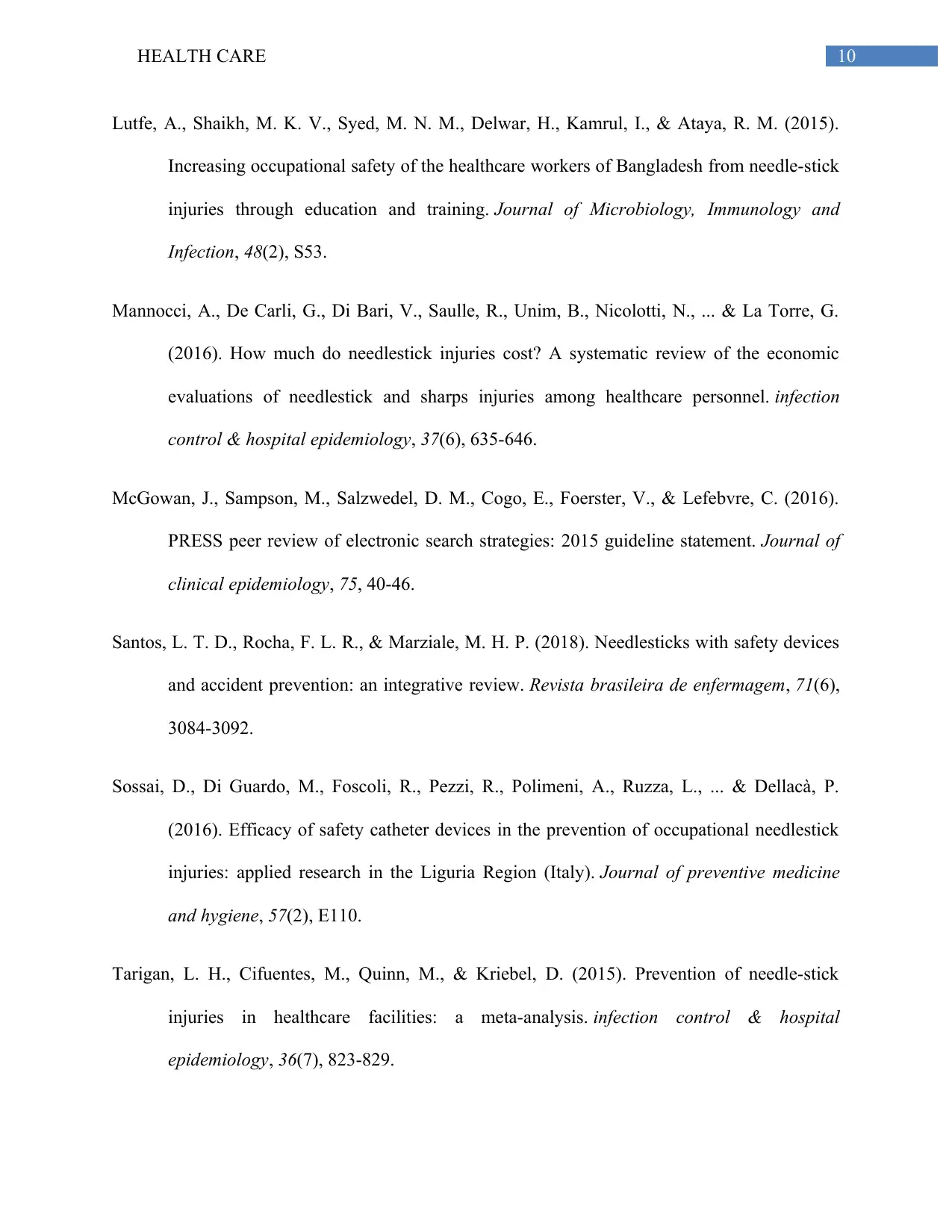
10HEALTH CARE
Lutfe, A., Shaikh, M. K. V., Syed, M. N. M., Delwar, H., Kamrul, I., & Ataya, R. M. (2015).
Increasing occupational safety of the healthcare workers of Bangladesh from needle-stick
injuries through education and training. Journal of Microbiology, Immunology and
Infection, 48(2), S53.
Mannocci, A., De Carli, G., Di Bari, V., Saulle, R., Unim, B., Nicolotti, N., ... & La Torre, G.
(2016). How much do needlestick injuries cost? A systematic review of the economic
evaluations of needlestick and sharps injuries among healthcare personnel. infection
control & hospital epidemiology, 37(6), 635-646.
McGowan, J., Sampson, M., Salzwedel, D. M., Cogo, E., Foerster, V., & Lefebvre, C. (2016).
PRESS peer review of electronic search strategies: 2015 guideline statement. Journal of
clinical epidemiology, 75, 40-46.
Santos, L. T. D., Rocha, F. L. R., & Marziale, M. H. P. (2018). Needlesticks with safety devices
and accident prevention: an integrative review. Revista brasileira de enfermagem, 71(6),
3084-3092.
Sossai, D., Di Guardo, M., Foscoli, R., Pezzi, R., Polimeni, A., Ruzza, L., ... & Dellacà, P.
(2016). Efficacy of safety catheter devices in the prevention of occupational needlestick
injuries: applied research in the Liguria Region (Italy). Journal of preventive medicine
and hygiene, 57(2), E110.
Tarigan, L. H., Cifuentes, M., Quinn, M., & Kriebel, D. (2015). Prevention of needle-stick
injuries in healthcare facilities: a meta-analysis. infection control & hospital
epidemiology, 36(7), 823-829.
Lutfe, A., Shaikh, M. K. V., Syed, M. N. M., Delwar, H., Kamrul, I., & Ataya, R. M. (2015).
Increasing occupational safety of the healthcare workers of Bangladesh from needle-stick
injuries through education and training. Journal of Microbiology, Immunology and
Infection, 48(2), S53.
Mannocci, A., De Carli, G., Di Bari, V., Saulle, R., Unim, B., Nicolotti, N., ... & La Torre, G.
(2016). How much do needlestick injuries cost? A systematic review of the economic
evaluations of needlestick and sharps injuries among healthcare personnel. infection
control & hospital epidemiology, 37(6), 635-646.
McGowan, J., Sampson, M., Salzwedel, D. M., Cogo, E., Foerster, V., & Lefebvre, C. (2016).
PRESS peer review of electronic search strategies: 2015 guideline statement. Journal of
clinical epidemiology, 75, 40-46.
Santos, L. T. D., Rocha, F. L. R., & Marziale, M. H. P. (2018). Needlesticks with safety devices
and accident prevention: an integrative review. Revista brasileira de enfermagem, 71(6),
3084-3092.
Sossai, D., Di Guardo, M., Foscoli, R., Pezzi, R., Polimeni, A., Ruzza, L., ... & Dellacà, P.
(2016). Efficacy of safety catheter devices in the prevention of occupational needlestick
injuries: applied research in the Liguria Region (Italy). Journal of preventive medicine
and hygiene, 57(2), E110.
Tarigan, L. H., Cifuentes, M., Quinn, M., & Kriebel, D. (2015). Prevention of needle-stick
injuries in healthcare facilities: a meta-analysis. infection control & hospital
epidemiology, 36(7), 823-829.
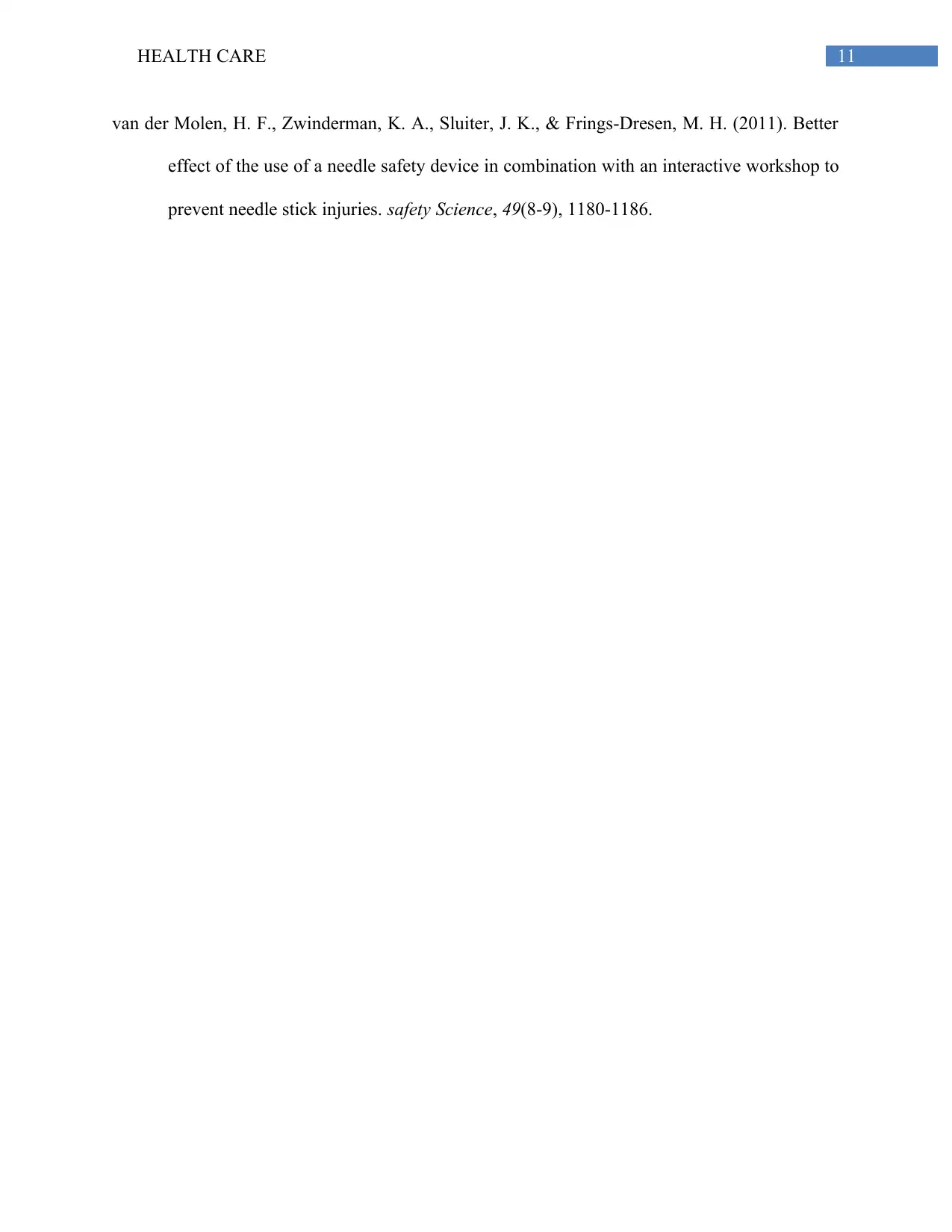
11HEALTH CARE
van der Molen, H. F., Zwinderman, K. A., Sluiter, J. K., & Frings-Dresen, M. H. (2011). Better
effect of the use of a needle safety device in combination with an interactive workshop to
prevent needle stick injuries. safety Science, 49(8-9), 1180-1186.
van der Molen, H. F., Zwinderman, K. A., Sluiter, J. K., & Frings-Dresen, M. H. (2011). Better
effect of the use of a needle safety device in combination with an interactive workshop to
prevent needle stick injuries. safety Science, 49(8-9), 1180-1186.
⊘ This is a preview!⊘
Do you want full access?
Subscribe today to unlock all pages.

Trusted by 1+ million students worldwide
1 out of 12
Related Documents
Your All-in-One AI-Powered Toolkit for Academic Success.
+13062052269
info@desklib.com
Available 24*7 on WhatsApp / Email
![[object Object]](/_next/static/media/star-bottom.7253800d.svg)
Unlock your academic potential
Copyright © 2020–2025 A2Z Services. All Rights Reserved. Developed and managed by ZUCOL.





